Are you considering building your dream mountain bike with premium components from scratch? If the answer is yes, you’ve come to the right place.
In this comprehensive article, we will take you through each step of the process, providing detailed insights on how to assemble a full-suspension mountain bike tailored to your preferences.
From setting a budget to selecting the finest components, we’ve got you covered.
The process of building a full-suspension mountain bike involves several steps:
Choose a suitable frame designed for full suspension that is compatible with the preferred wheel and shock sizes as well as riding style.
Gather all necessary components like shocks, linkages, rear triangles, front end, gears, brakes, and wheels that fit the frame and intended riding preferences.
Assemble the bike by piecing together the rear triangle, modifying the front end if needed, creating linkages, and correctly installing all components onto the frame following manufacturer instructions.
Fine-tune and test the bike by adjusting suspension settings, brakes, and gears.
Perform safety checks and test rides to evaluate its performance and make necessary adjustments for comfort and efficiency.
Ensure all bolts are properly tightened, and cables correctly routed, and check that the bike functions smoothly and safely. Make additional customizations based on personal preferences if desired.
It is advisable to seek professional assistance from bike shops or experienced mechanics to ensure safety during assembly.
Defining Full-Suspension Bikes and Their Benefits

A full-suspension mountain bike, often referred to as a “full-susser,” is a type of bike equipped with both front and rear suspension systems.
This design distinguishes it from hardtail bikes, which only have front suspension. The advantages of opting for a full-suspension bike are numerous and include:
- Improved Traction: The rear suspension system allows the rear wheel to maintain consistent contact with the ground, providing superior traction, especially on uneven terrain.
- Enhanced Comfort: The dual suspension setup absorbs shocks and impacts, reducing rider fatigue and ensuring a more comfortable experience, especially during extended rides.
- Heightened Control: Full-suspension bikes offer increased stability and control, enabling riders to confidently tackle challenging trails and obstacles.
- Increased Speed: The suspension system aids in maintaining momentum by keeping the wheels in contact with the ground, resulting in faster descents and improved climbing capabilities.
Planning for Building a Full-Suspension Mountain Bike

Setting a Budget: Assembling Excellence on a Budget
Making your dream full-suspension mountain bike begins with setting a budget. This step ensures you make a bike that meets your needs without breaking the bank.
Start by determining the maximum amount you will spend on your project. Consider allocating funds for essential components such as the frame, suspension system, brakes, and drivetrain.
Transitioning to the build phase, prioritize quality over quantity. Look for budget-friendly options without compromising durability.
Researching and comparing prices across different suppliers can help you make informed decisions. Consider used components in good condition to save costs, but always verify their compatibility with your build.
The key to a successful full-suspension mountain bike project is setting a realistic budget to manage your finances effectively while still achieving excellence in assembling the bike.
Identifying Your Riding Style: Tailoring Components to Your Unique Needs
Understanding your riding style is crucial in selecting components that enhance your biking experience. Whether you’re a downhill enthusiast, trail rider, or cross-country adventurer, tailoring your bike to your unique needs ensures optimal performance.
For downhill riders seeking thrills, a frame with 180mm or more suspension travel and a coil-sprung shock is ideal.
Trail riders might prefer a balance of suspension travel and agility, while cross-country bikers prioritize lightweight and efficiency.
By identifying your riding style, you can tailor your full-suspension mountain bike with components that align with your preferences, creating a customized ride that suits your adventure.
Frameset System needed to build a full suspension mountain bike
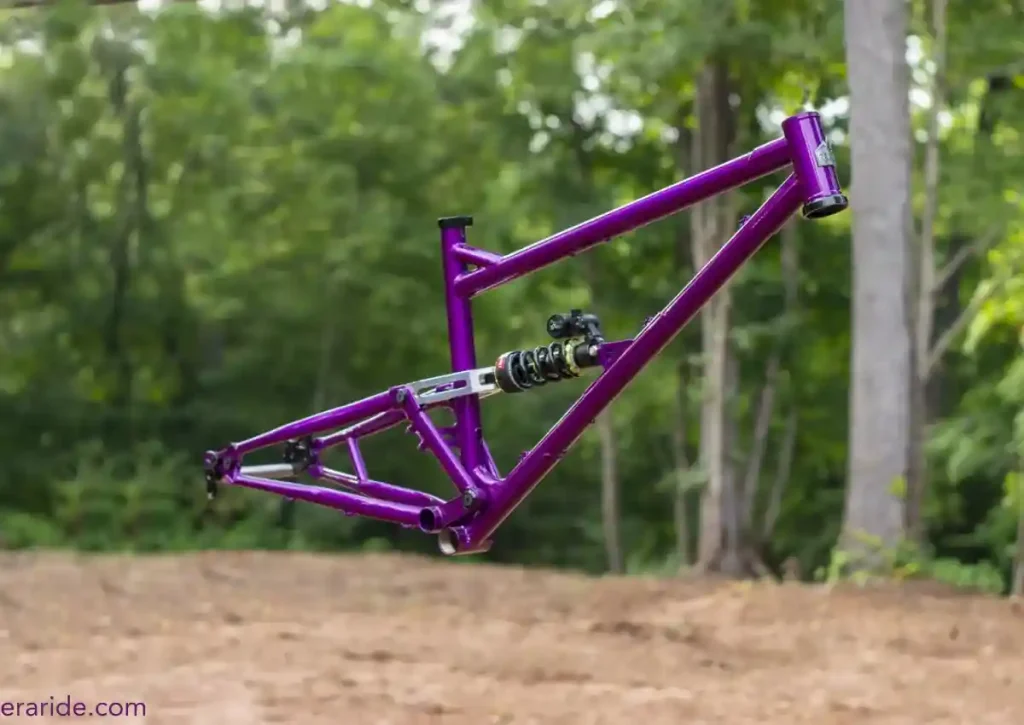
Frame Material Dilemma: Navigating Carbon Fiber, Alloy, Steel, and Titanium
Choosing the right frame material is crucial for the performance and durability of your full-suspension mountain bike.
Carbon fiber offers lightweight versatility, ideal for those seeking agility on the trails.
Alloy frames provide a balance of strength and affordability, suitable for budget-conscious builders.
Steel frames offer robust durability, perfect for riders tackling rugged terrains.
Titanium frames, known for their strength and lightness, cater to riders looking for a premium, long-lasting option.
When navigating the frame material dilemma, consider your riding style, budget, and preferences. Each material has its unique characteristics,
Decoding Frame Geometry: Finding the Perfect Head Tube Angle
Finding the Perfect Head Tube Angle Frame geometry plays a pivotal role in the handling and responsiveness of your full-suspension mountain bike.
The head tube angle, in particular, determines steering stability. For downhill adventures, a slacker angle (around 65 degrees) enhances control, while a steeper angle (around 70 degrees) suits cross-country riders seeking quick maneuverability.
Decoding frame geometry involves understanding how different angles influence your riding experience. Tailor the head tube angle to match your intended riding style, ensuring a customized and optimized biking adventure.
Handlebars: Riser or Flat? Material, Size, and Style Considerations
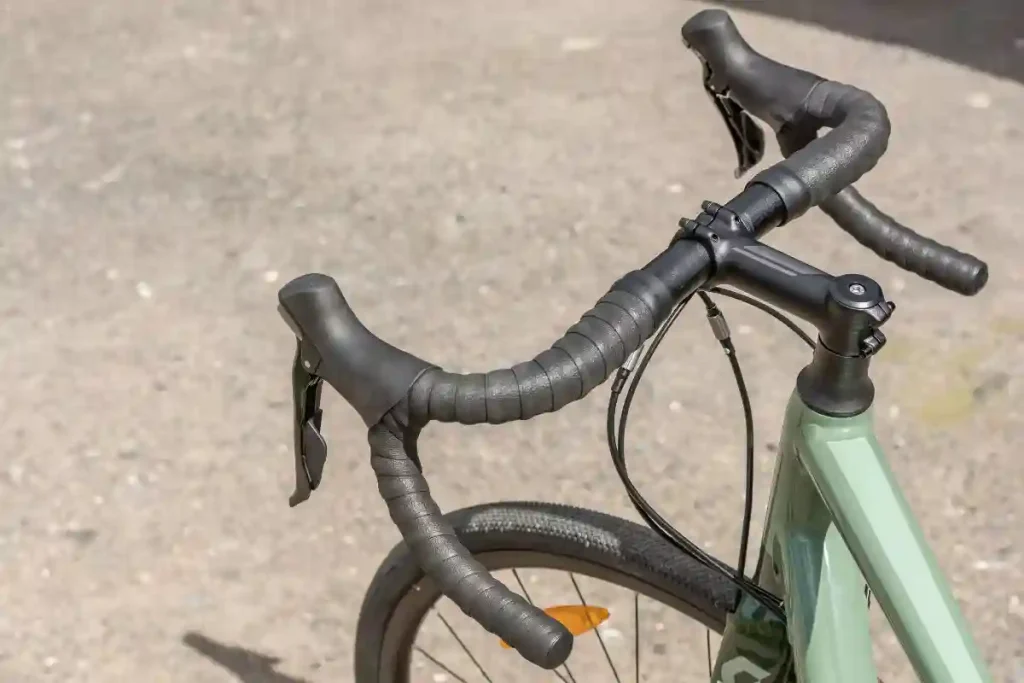
Selecting the right handlebars is key to achieving comfort and control. Choose between riser and flat handlebars based on your riding style.
Riser bars provide a more upright position, suitable for technical trails. Flat bars offer a lower profile, ideal for cross-country riders seeking an aerodynamic position.
Consider the material, size, and style of handlebars to match your preferences. Aluminum and carbon are common materials, each with its advantages.
Ensure the size complements your body proportions, and the style aligns with your riding goals.
Stem Selection: Tailoring Your Ride with Precision
Selecting the right stem is about tailoring your ride with precision. Consider the stem length and angle to achieve the desired riding position.
A shorter stem enhances maneuverability, suitable for technical trails, while a longer stem promotes stability during high-speed descents.
When making stem choices, align them with your handlebar selection for a cohesive and comfortable riding experience.
The combination of stem and handlebar directly influences bike handling, ensuring a full-suspension mountain bike that responds precisely to your input.
Navigating Headsets: FSA, Cane Creek, and the Art of Integration
When assembling your full-suspension mountain bike, selecting the right headset is crucial for a smooth and integrated system. Brands like FSA and Cane Creek offer quality options.
Consider factors like durability, bearing quality, and compatibility with your frame. Ensure seamless integration, allowing your bike to handle trails with precision.
Transitioning between FSA and Cane Creek headsets involves understanding the nuances of each brand. FSA often provides budget-friendly choices, while Cane Creek focuses on high-performance options. Carefully analyze your riding style and budget constraints to make an informed decision.
Seat Post Options: Rigid or Dropper, Making the Right Choice
Choosing the right seat post enhances comfort and control during your mountain biking adventures. The decision between a rigid and a dropper seat post depends on your riding style and preferences.
For riders seeking simplicity and lightweight design, a rigid seat post is a suitable choice. It provides stability and efficient power transfer.
On the other hand, a dropper seat post offers versatility, allowing you to adjust saddle height on the fly, particularly beneficial for varied terrains.
Evaluate your riding needs and terrain preferences to make an informed decision.
The right seat post choice complements your full suspension system, contributing to a well-balanced and enjoyable ride.
Seat Clamp Essentials: Finding the Perfect Fit
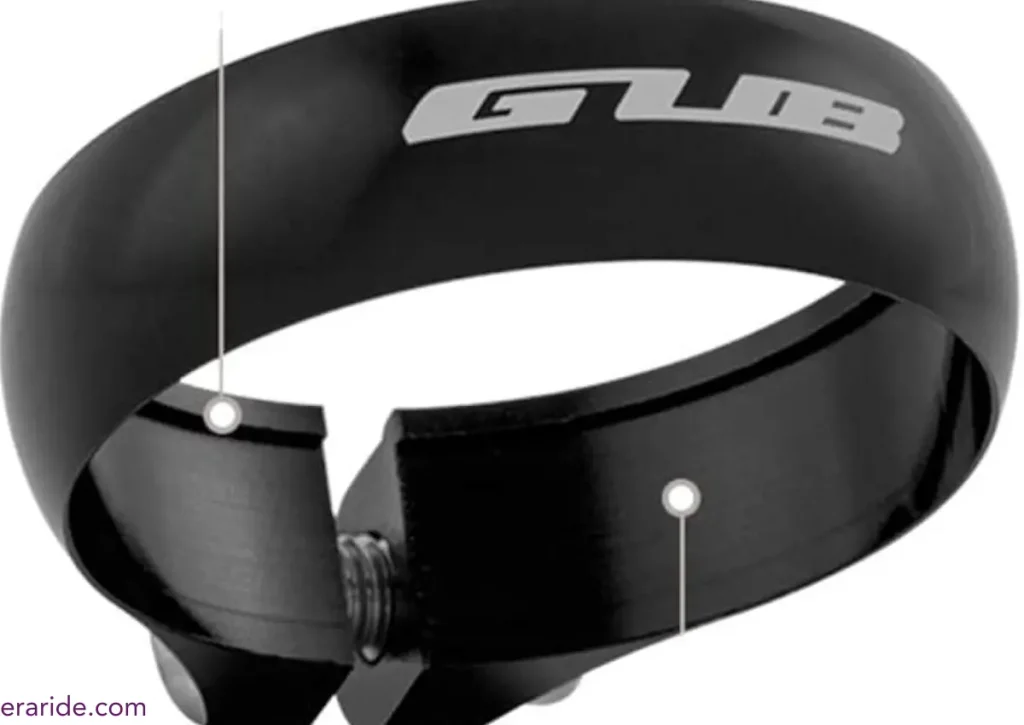
Ensuring your seat post stays securely in place requires the right seat clamp.
Finding the perfect fit involves considering the seat tube diameter of your frameset and the type of seat post you’ve chosen.
A secure and well-fitted seat clamp guarantees stability during rides, preventing any unwanted slippage or movement.
Explore different options based on materials like aluminum or carbon, striking the right balance between durability and weight.
Take accurate measurements of your seat tube diameter and choose a seat clamp that aligns perfectly. Proper installation ensures a snug fit, enhancing the overall reliability of your full-suspension mountain bike.
Saddle Selection: Balancing Weight, Comfort, and Performance
Picking the right saddle is a game-changer in optimizing your full-suspension mountain bike.
It’s all about finding that sweet spot between weight, comfort, and performance. Factors like saddle width, padding, and material come into play.
Be proactive by trying out different saddle options to discover the perfect fit for your body and riding style. Transition smoothly between terrains with a saddle that offers comfort without sacrificing performance.
A well-chosen saddle is the secret ingredient to heightening your overall biking pleasure.
Read more: Do You Need Suspension in a Dirt Jumper?
A Wheelset System is Needed for assembling a full-suspension mountain bike
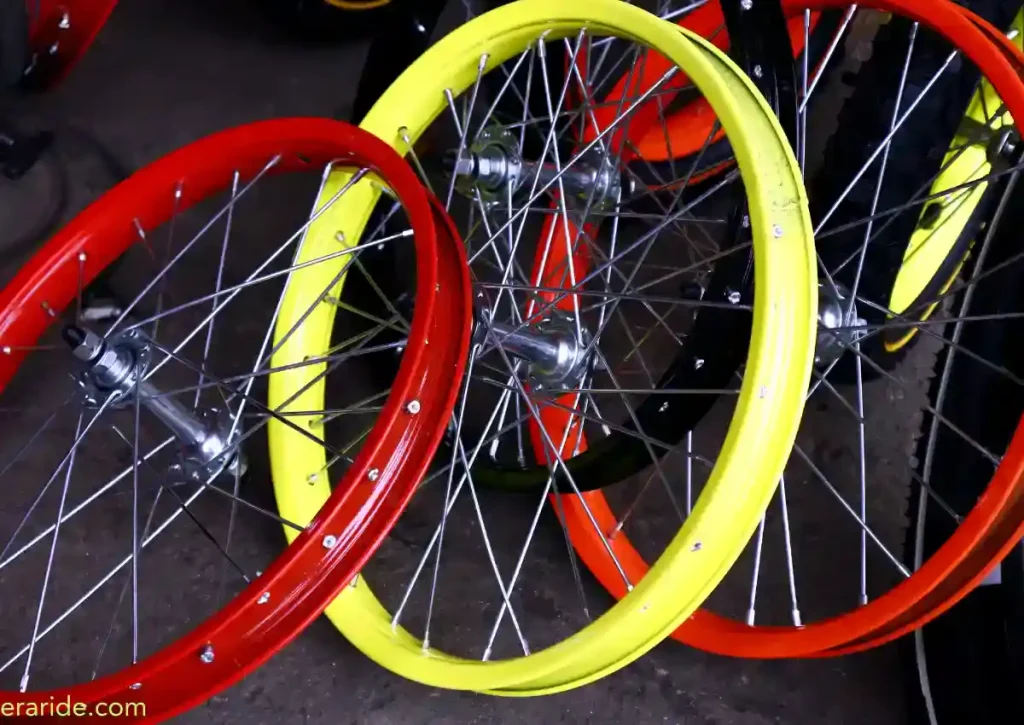
Hubs, Rims, and Spokes: Unlocking the Secrets to a Stellar Wheelset
Crafting a high-performance full-suspension mountain bike begins with understanding the core elements of your wheelset. Hubs, rims, and spokes collectively form the backbone, influencing your bike’s ride quality and durability.
Hubs: These central components house the bike’s bearings, allowing the wheels to spin smoothly. Opt for hubs with sealed bearings for enhanced longevity, reducing the need for frequent maintenance. Brands like DT Swiss and Chris King are renowned for their reliable hub options.
Rims: Consider the terrain you’ll be conquering. Sturdier rims are ideal for rough trails, offering increased durability. Tubeless-ready rims provide the added benefit of reduced flats and improved traction.
Spokes: The spokes connect the hubs to the rims, providing structural integrity. Choose butted spokes for a balance of strength and weight savings.
An active approach to selecting hubs, rims, and spokes ensures a wheelset that unlocks the secrets to a stellar riding experience.
Thru-Axle Systems: Navigating the Evolution of Mountain Bike Axles
The evolution of mountain bike axles has introduced the thru-axle system, enhancing stability and control. Thru-axles provide a more secure connection between the wheel and frame, reducing flex and improving steering precision.
Transitioning from traditional quick-release axles to thru-axle systems demands careful consideration of your bike’s compatibility.
Most modern full-suspension mountain bikes are equipped with thru-axles, but it’s essential to verify the specifications.
Navigating this evolution ensures your bike benefits from the enhanced stiffness and responsiveness offered by thru-axle systems.
An active approach to selecting hubs, rims, and spokes ensures a wheelset that unlocks the secrets to a stellar riding experience.
Disc Rotors: 6-Bolts vs. Center Lock – Breaking Down Your Options
Disc rotors play a critical role in the braking performance of your full-suspension mountain bike. Understanding the options between 6-bolt and Center Lock systems allows you to tailor your braking setup to your preferences.
6-Bolts: This traditional system involves attaching the rotor to the hub with six bolts. It provides a secure connection and is widely compatible with various hubs and bikes.
Center Lock: Developed by Shimano, this system features a splined interface for rotor attachment. It offers quick and easy installation, making it a popular choice.
Choosing between 6-bolts and Center Lock depends on factors like ease of use, compatibility, and personal preference, ensuring your braking system aligns with your riding needs.
Read more: How Do Mountain Bike Disc Brakes Work?
Tire Valves: Presta vs. Schrader – Making the Right Valve Choice
Selecting the right tire valves contributes to overall tire performance and maintenance. The choice between Presta and Schrader valves involves considerations of compatibility and convenience.
Presta Valves: These slender valves are commonly found on high-performance bikes. They feature a locknut for secure closure, minimizing air loss during rapid descents.
Schrader Valves: Standard on most car tires, Schrader valves are wider and have a spring-loaded mechanism. They are user-friendly and compatible with various air pumps.
Making the right valve choice ensures hassle-free inflation and compatibility with your chosen rims. Consider your riding style and preferences to decide between Presta and Schrader valves for a seamless wheelset experience.
Drivetrain System for Full-Suspension Mountain Bike
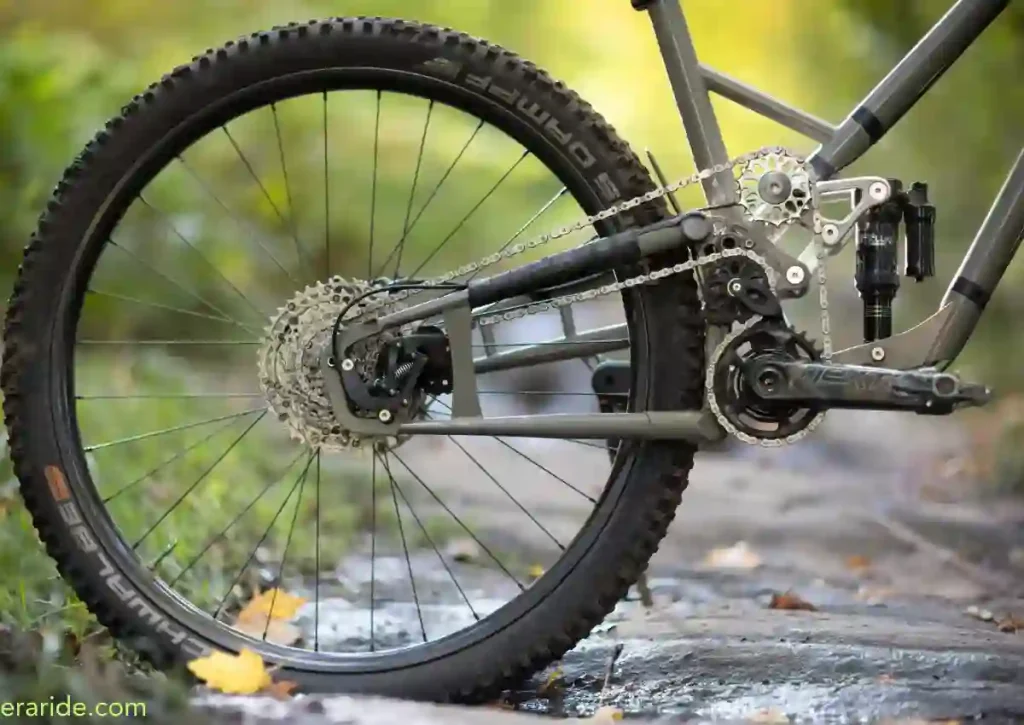
Shimano vs. SRAM: Choosing the Heart of Your Drivetrain
When it comes to your full-suspension mountain bike’s drivetrain, the choice between Shimano and SRAM is paramount. Both brands offer a range of options, each with its unique features.
Shimano: Known for precision and reliability, Shimano drivetrains are popular among riders seeking consistent and smooth gear shifts. The brand’s extensive lineup caters to various riding styles and preferences.
SRAM: Embraced for innovation, SRAM drivetrains often feature cutting-edge technologies. Riders looking for a lightweight and efficient system with quick and precise shifts often lean towards SRAM.
Make an informed decision based on your riding needs, preferences, and budget, ensuring the heart of your drivetrain aligns seamlessly with your biking goals.
Bottom Bracket Considerations: Ensuring a Perfect Fit
The bottom bracket is a critical component linking your drivetrain to the bike frame. Choosing the right one ensures a perfect fit and optimal power transfer.
Consider your bike’s frame specifications and the type of crankset you’ve chosen. Different bikes may require specific bottom bracket standards, such as threaded, press-fit, or BB30. Ensure compatibility for a smooth and efficient connection between the crankset and frame.
Shifting Methods: Electric vs. Mechanical – Exploring the Cutting Edge
In the realm of shifting methods, riders now have the option of traditional mechanical systems or cutting-edge electric systems.
Mechanical Shifting: Reliable and familiar, mechanical shifting systems use cables to move the derailleurs, providing a tactile feel. They are durable and easy to maintain.
Electric Shifting: Embracing technology, electric shifting systems use electronic signals for precise and instantaneous shifts. They often appeal to riders seeking a high-tech and efficient experience.
Explore the pros and cons of each system, considering factors like personal preference, budget, and desired level of technology integration.
Choosing Your Pedals: Clip or Flat – Aligning with Your Riding Style
The choice between clip pedals and flat pedals significantly influences your riding experience. Each type caters to different styles and preferences.
Clip Pedals: Ideal for avid mountain bikers, clip pedals provide a secure connection between the shoe and pedal, enhancing power transfer and control. They are popular among those tackling challenging terrains.
Flat Pedals: Embraced by riders who prioritize ease of use and the ability to quickly put a foot down, flat pedals offer simplicity and versatility. They are suitable for various riding styles, including trail and casual biking.
Align your pedal choice with your riding style, skill level, and comfort, ensuring a harmonious connection between you and your bike.
Selecting the Suspension System for Your Full-Suspension Mountain Bike
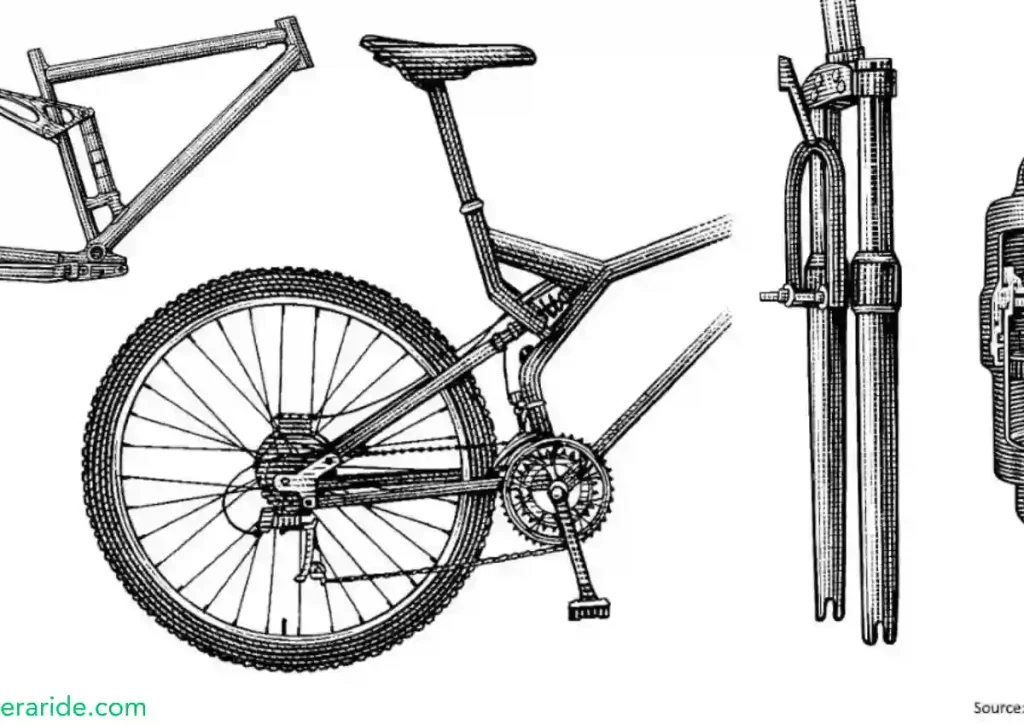
Rear Shock Essentials: Mount Types, Sizes, and Bushing Kits
When it comes to your full-suspension mountain bike’s rear shock, understanding the essentials is crucial for a smooth and responsive ride.
Mount Types: Rear shocks come with different mounting options. The most common are eyelet mounts and trunnion mounts. Ensure compatibility with your bike frame, considering factors like eye-to-eye length and stroke.
Sizes: Rear shocks vary in size, influencing the travel and overall performance of your bike. Consider the manufacturer’s recommendations and your riding style when choosing the right size.
Bushing Kits: Bushings play a vital role in the performance of your rear shock. Regular maintenance and, if needed, replacement of bushing kits ensure optimal function and longevity.
An active approach to selecting your rear shock components guarantees a suspension system that meets your bike’s specific requirements.
Front Suspension Fork Mastery: FOX vs. RockShox and the Ideal Travel
Mastering the front suspension fork is essential for tackling diverse terrains on your full-suspension mountain bike.
FOX vs. RockShox: These two brands dominate the mountain bike suspension market. FOX forks are praised for their precision and adjustability, while RockShox forks are known for their plush feel and user-friendly features. Consider your preferences and budget when choosing between the two.
Ideal Travel: The travel of your front suspension fork determines its ability to absorb impacts. For cross-country riding, opt for shorter travel (100-120mm). For more aggressive trail riding, consider longer travel (140-160mm). Match the fork’s travel with your riding style and the type of trails you’ll conquer.
Active riders make informed choices, ensuring the front suspension fork aligns seamlessly with their biking preferences and the challenges of the trail ahead.
Essential Tools for Building a Full Suspension Mountain Bike
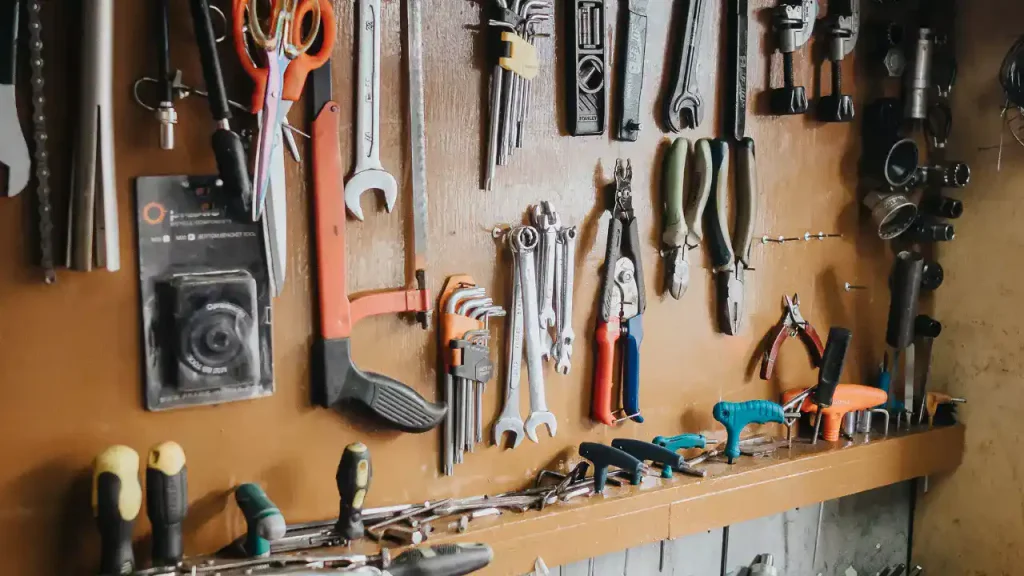
Before embarking on the construction of your full-suspension mountain bike, it is essential to gather the necessary tools. Here is a comprehensive list of what you’ll need:
- Hex Wrench Set: This set is invaluable for adjusting bolts and screws on various components.
- Torque Wrench: Ensure bolts are tightened to the manufacturer’s specifications, preventing over-tightening or under-tightening.
- Chain Tool: Used for sizing and installing the chain to fit your specific drivetrain.
- Bottom Bracket Tool: Necessary for removing and installing the bottom bracket, a critical component for smooth pedaling.
- Suspension Pump: Specifically designed to adjust the air pressure in your suspension forks and shocks, it allows you to fine-tune your bike’s performance.
- Cable and Housing Cutters: These precision tools are used for cutting brake and derailleur cables and housing.
- Pedal Wrench: Essential for installing and removing pedals.
- Crank Puller: This tool is used to remove the crankset from the bottom bracket.
- Headset Press: Essential for correctly installing the headset and ensuring smooth steering.
- Grease and Lubricants: Keep your components running smoothly and prevent premature wear.
- Stand or Workstand: Provides a stable platform to work on your bike, allowing easy access to all components.
- Bike Cleaning Kit: Includes brushes, degreasers, and cleaners to keep your bike in top condition.
- Safety Gear: Essential items such as gloves, safety glasses, and a first-aid kit ensure your protection throughout the build process.
- Owner’s Manual and Schematics: These reference materials, provided by the bike’s manufacturer, guide you through the assembly process.
Bike Stand Workstation: Elevating Your Workspace
Building your full-suspension mountain bike starts with a solid foundation – a reliable bike stand workstation. Elevate your workspace for easy access to every part of your bike.
A sturdy stand keeps your bike secure, allowing you to work efficiently on various components without the hassle of constantly bending or reaching.
Invest in a quality bike stand, and you’ll find that your entire build process becomes more streamlined and enjoyable.
Allen Keys, Pedal Wrench, and Torque Wrench: Precision in Every Detail
Assemble your full-suspension mountain bike with precision by having the right tools at your disposal. Allen keys, a pedal wrench, and a torque wrench are essential for securing components with accuracy. Allen keys tackle various bolts, the pedal wrench ensures proper pedal installation, and the torque wrench guarantees that every bolt is tightened to the manufacturer’s specifications. Achieve a secure and safe build by embracing the power of precision with these indispensable tools.
Bike Grease: Ensuring Smooth Functionality
Smooth functionality is the key to an enjoyable ride, and bike grease is your ally in achieving it. Apply bike grease to crucial contact points like bearings and threads to reduce friction and prevent corrosion.
This simple step ensures that your bike operates seamlessly, prolonging the lifespan of your components.
A small investment in bike grease goes a long way in maintaining the overall health and performance of your full-suspension mountain bike.
Floor Pump and Shock Pump: Inflating Confidence Into Your Ride
Inflate confidence into your ride by having the right pumps on hand. A floor pump is essential for maintaining proper tire pressure, ensuring a smooth and controlled ride.
Additionally, a shock pump allows you to fine-tune the suspension, customizing it to your weight and riding style.
With the correct pressures, your full-suspension mountain bike performs optimally, enhancing both comfort and control on various terrains.
Sealant and Cloth: Finishing Touches for a Polished Build
The finishing touches matter, and sealant and a cloth add the final polish to your full suspension mountain bike build.
Sealant is crucial for tubeless setups, preventing flats and enhancing tire performance. Keep a cloth handy for wiping down surfaces and ensuring a clean, professional look.
These small details contribute to the overall aesthetics and functionality of your bike, providing the perfect conclusion to your full suspension masterpiece.
Read more: Mountain Bike Drop Bars
Queries about how you can build a full-suspension mountain bike in 2024
Yes, full suspension is beneficial for mountain biking. It provides improved comfort, traction, and control, especially on rough terrains. Full-suspension bikes absorb impacts, enhancing the overall riding experience.
Can you build your mountain bike?
Yes, you can assemble your mountain bike. Detailed guides available at eraride, such as “How to Assemble a Full Suspension Mountain Bike” on Instructables, or video tutorials like “How To Assemble Your First Mountain Bike,” provide step-by-step instructions.
What makes a bike have full suspension?
A bike has full suspension when it features both front and rear suspension systems. This typically includes a front fork and a rear shock, allowing the bike to absorb impacts from bumps and uneven terrain.
Is it OK to hang a full-suspension mountain bike?
Yes, it’s generally okay to hang a full-suspension mountain bike. However, use a proper bike rack or hanger to avoid damaging the frame or components.
What are the disadvantages of bike suspension?
Suspension systems can add weight and maintenance complexity to a bike. Some riders may prefer the simplicity of a hardtail for certain conditions or disciplines.
How do you set up a full-suspension bike?
Setting up a full-suspension bike involves adjusting sag, rebound, and compression settings on the front fork and rear shock. Follow the manufacturer’s guidelines and consider your weight and riding style for optimal performance.
Is it cheaper to build a custom MTB?
Building a custom mountain bike can be cost-effective if you already have some components. However, it depends on the quality of the parts chosen. Compare prices to determine the most economical option.

